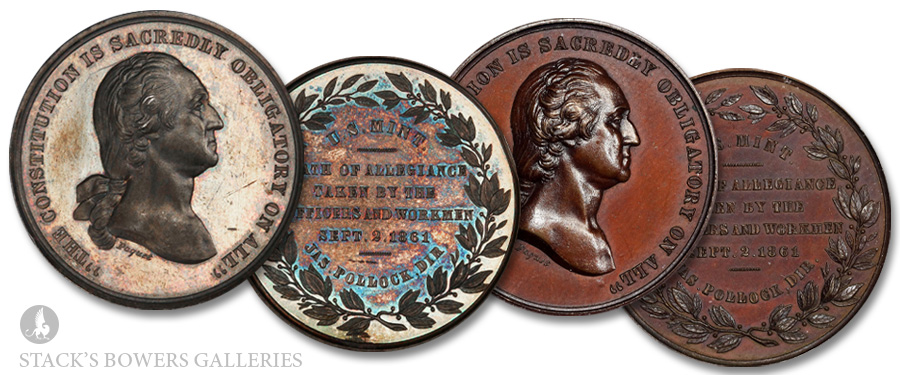
After the seizure of the Southern branch mints by the Confederacy at the outset of the Civil War, the loyalty of Mint employees was taken seriously at the facilities remaining under federal control. Employees took an oath of allegiance to the Union and medals were struck commemorating it.
Anthony Paquet, then assistant engraver at the Mint, adapted a portrait used for the Washington Medal Cabinet Collection medal and prepared a simple reverse with text explaining that “U.S. Mint OATH OF ALLEGIANCE TAKEN BY THE OFFICERS AND WORKMEN, SEPT. 2, 1861” encircled by a laurel wreath.
Cataloged as Baker-279, (R.7), Julian-CM2, and Musante GW-476, the medals were produced through the 19th century and into the 20th in three metallic compositions, according to Mint delivery records.
A 2023 CoinWeek article by Roger Burdette suggests that the oath taken by Mint workers and employees likely read like this:
“I do solemnly swear (or affirm, as the case may be) that I will support, protect, and defend the Constitution and Government of the United States against all enemies, whether domestic or foreign, and that I will bear true faith, allegiance, and loyalty to the same, any ordinance, resolution, or law of any State convention or legislature to the contrary notwithstanding; and, further, that I do this with a full determination, pledge, and purpose, without any mental reservation or evasion whatsoever; and, further, that I will well and faithfully perform all the duties which may be required of me by law. So help me God.”
Loyalty to the Union – or lack thereof – was a constant theme on tokens and medals of the period. Civil War tokens bore designs wishing death upon traitors and exhorting the preservation of the Union. The U.S. Mint produced a range of medals honoring successful generals, and some private citizens and numismatists like Augustus B. Sage commissioned medals commemorating battles and major figures.





